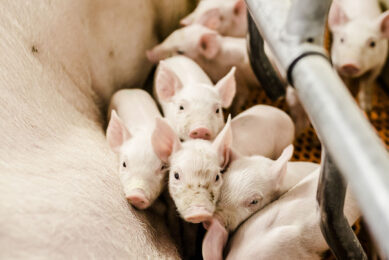Supporting piglet livability has long term gains

New nutritional strategies help to prevent stillbirths and pre-weaning mortality. They can play a major role in supporting sows in raising more of their litter. Success in these early stages will make a significant contribution to both piglet livability and to sow unit efficiency.
Maintaining piglet livability in today’s larger litter sizes is a challenge for producers. Many factors contribute to its success:
- genetics,
- nutrition and
- management.
New nutritional strategies help to prevent stillbirths and pre-weaning mortality. They can play a major role in supporting the sow in raising more of her litter. Success in these early stages will make a significant contribution to piglet livability and sow unit efficiency.
Calculating piglet livability
The box shows how piglet livability is calculated. The effect of stillbirths and pre-weaning mortality is clear. A 5% increase in livability, by reducing stillbirths and improving pre-weaning mortality, can improve sow productivity by nearly 2 weaned piglets per sow per year, equivalent to $ 50 (or € 47) additional income per sow.
Figure 1 – Factors affecting piglet livability related to larger litters.

A survey carried out by Cargill in 2016 showed that piglet livability ranged from 75% to 90% in the main pig producing European countries. At the same time, larger litter sizes resulting from improved genetics, sow nutrition, herd health and management, mean that there are more piglets to rear. These factors highlight the potential for improvements in piglet livability.
In the last decade, there has been an improvement of 0.3 weaned piglets per sow across Europe every year. This is equivalent to an increase of 1.5 weaned piglets per sow per year in 5 years. This higher productivity is still not at a level that reflects the increased potential from genetic improvement. The discrepancy relates to an increase in stillborn piglets and pre-weaning mortality, both factors that depress piglet livability. Factors affecting piglet livability are shown in Figure 1.
Figure 2 – Relationship between birth weight and survival of piglets.

Livability research
Improving piglet livability is central to Cargill’s research programmes. This has led to the development of new nutritional strategies that are proving to be the way forward. Enhanced nutrition along with better management of the sow and of the piglet from birth to weaning can have a positive impact on stillbirths and pre-weaning mortality.
Supporting a flying start
Nutritional programmes that target critical areas in the sow’s production cycle will support embryo development during pregnancy, help deliver large litters during parturition and meet piglet nutritional requirements – for the whole litter – during lactation. These all contribute to providing the piglet with a good healthy start to life and successful growth from nursery until finishing.
Cargill has developed Livelle sow programmes to address the needs of highly productive sows. These programmes combine the latest advances in nutrition and target 2 key periods that affect piglet livability:
- the weaning to oestrus interval and
- the transition between gestations to early lactation.
The addition of Livelle Profert in sow diets from weaning to oestrus has been shown, in Cargill trials, to improve piglet birthweights by up to 11.5% and reduce the proportion of small piglets in a litter by 40%. Helping the sow to farrow as many piglets as possible of birth weights of 1 kg or above is a key driver for increasing livability, see Figure 2
Cargill’s research has demonstrated that by feeding sows with a diet formulated according to the Livelle Transition concept around parturition can significantly increase piglet birthweight by 2.7% and piglet viability by 2.1%.
Automatic feeding system in the farrowing crate
The other key development from Cargill is the Neopigg RescueCare system for piglets. This is an automatic liquid feeding system that can supply fresh ad lib feed, 24/7 to piglets in the farrowing crate. Neopigg RescueMilk 2.0 complements the sow’s milk until 14 days of age, followed by the liquid prestarter Neopigg Smooth 2.0.
Pig farmers using the automatic liquid feeding system in the farrowing crate have seen that it can improve pre-weaning mortality while increasing the average piglet weaning weight by up to 0.8 kg. This resulted in an improvement in livability by 2% to 4%, and an average litter weight increase of 15 kg at weaning. The roles of these 2 nutritional feeding systems are shown in Figure 3.
By integrating these feeding programmes into the gestating and lactating phases, it is possible to achieve the aforementioned 5% increase in livability.
Figure 3 – Supporting programmes in sow production cycle.

On farm action
Producers are recording performance through a range of monitoring systems. They should use key performance indicators to monitor piglet livability trends, regardless of the number of weaned piglets per sow per year. It is very easy to ignore declining trends in livability when, overall, piglet numbers are rising. While larger litter sizes might be adding to the number of weaned pigs, the unit’s piglet livability could be falling and this would be limiting the chance of increasing sow farm efficiency in a sustainable way.
Working closely with Cargill’s specially trained nutritionists, each unit will develop its own nutritional strategy that meets its objectives and works within the resources available.
New rationing programmes, enhanced feed additives and feeding systems are all part of the remit for progressive sow units and regular evaluation of the system is required.
The economics of improved pig livability are well-proven. For most units, it is possible to raise the benchmark for this parameter with improved nutritional programmes that will support the sow and the litter. This in turn opens the door to improvements in sow unit efficiency and sustainability.
What is piglet livability?

Author: Marc Decoux, global technology leader, swine, Cargill
 Beheer
Beheer





 WP Admin
WP Admin  Bewerk bericht
Bewerk bericht